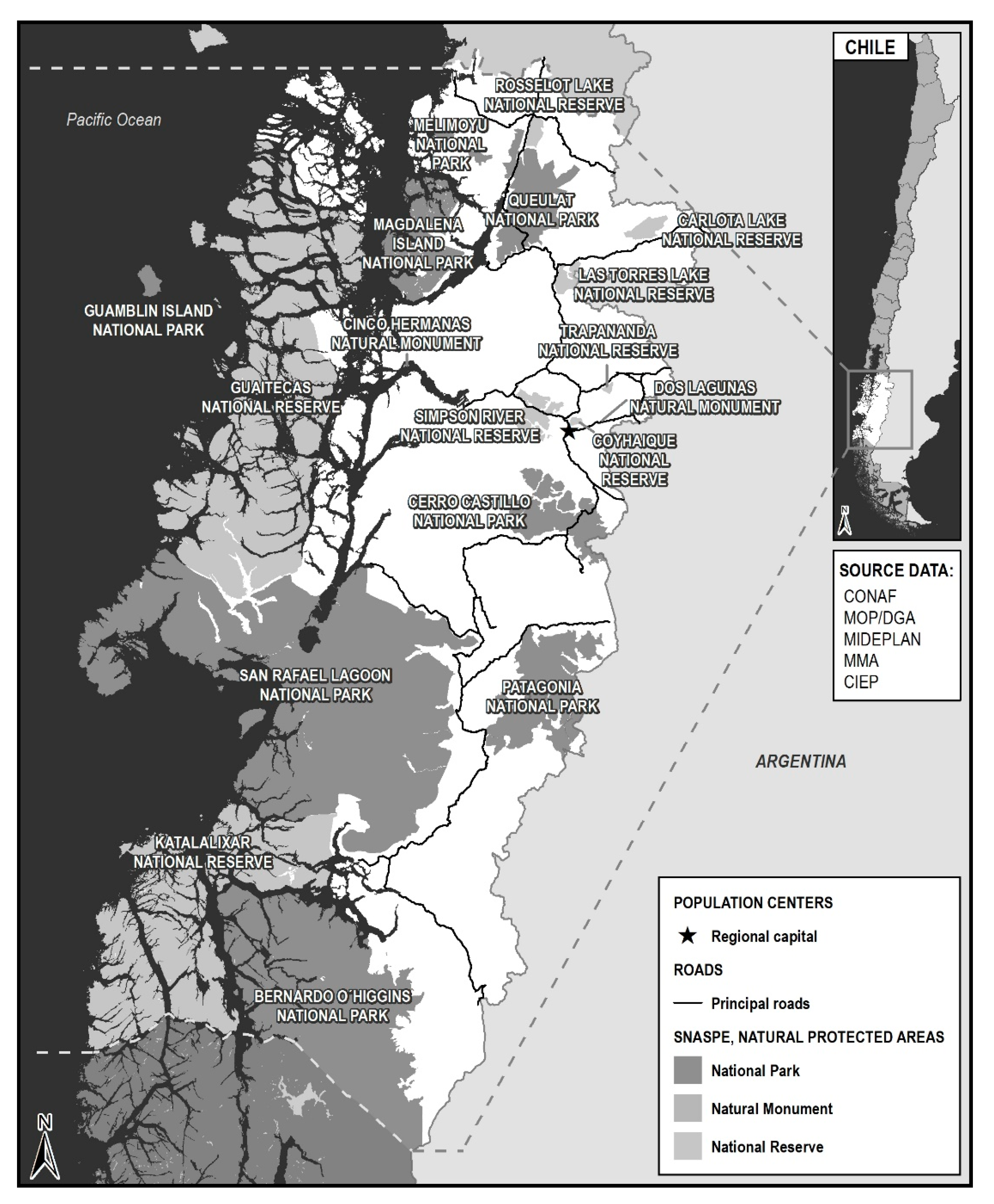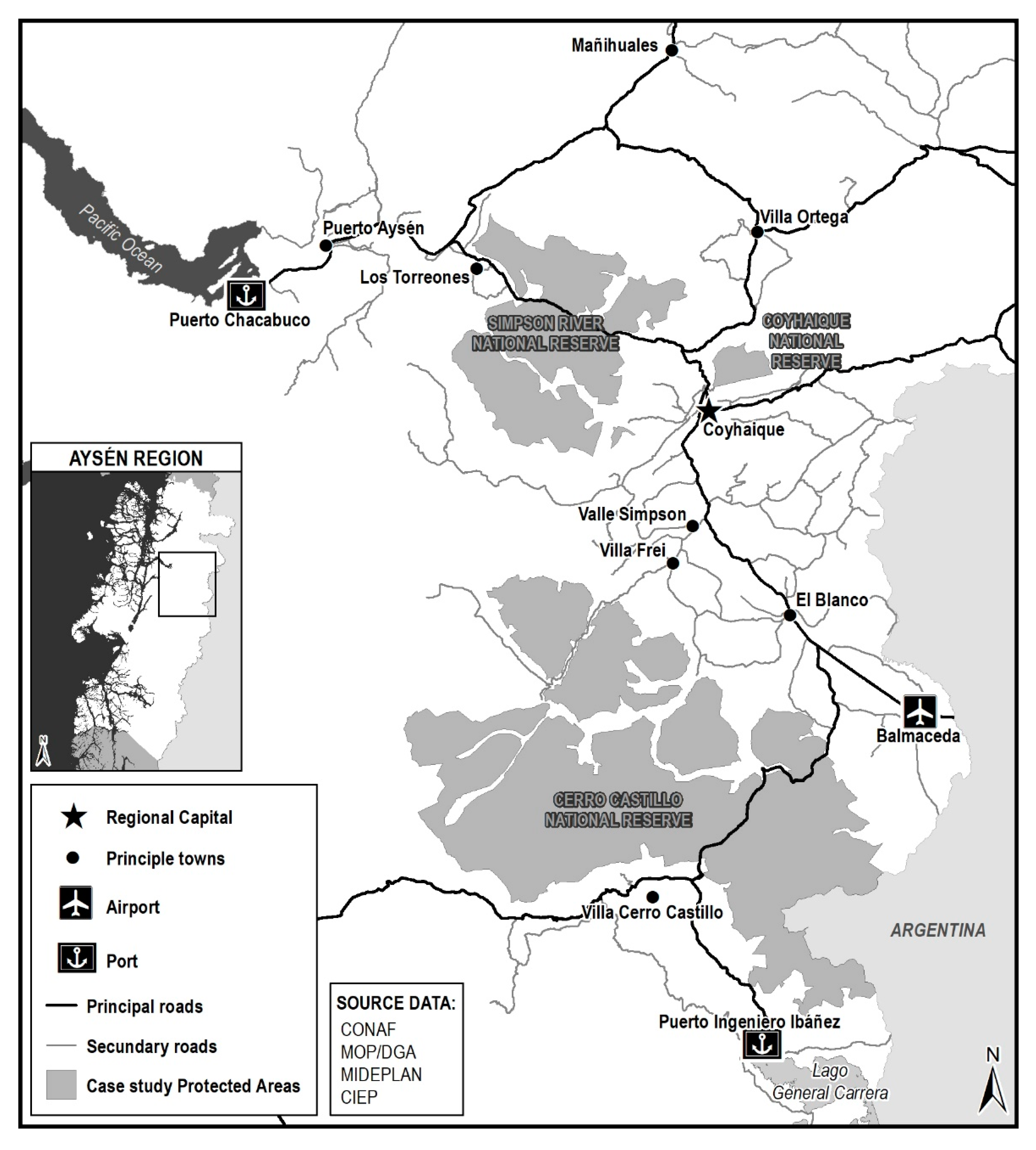Protected Areas, Tourism, and Rural Transition in Aysén, Chile
Abstract
:1. Introduction
1.1. Rural Transitions: Public lands, Tourism and Amenity Migration
1.2. Context of the Case Study
2. Materials and Methods
2.1. Overview and Research Questions
- How do local residents and actors concerned with the public use of the CCNPA perceive the changes that accompany of rural development?
- What do these perceptions reveal about center-periphery dynamics in Chile?
- How can these perceptions inform protected area management in areas experiencing rural transitions?
2.2. Research Design and Justification
2.3. Data Processing
3. Results
3.1. Thematic Results
3.2. Narrative Results
4. Discussion
4.1. Framework for Comparison across Geographies
4.2. Increasing Understanding of Lived Experiences and Perspectives of Rural Development
4.3. Stakeholder Perceptions and Central-Periphery Dynamics
4.4. Land Management in Areas Experiencing Rural Transitions
5. Conclusions
Author Contributions
Funding
Acknowledgments
Conflicts of Interest
References
- Vaccaro, I.; Beltran, O. Consuming Space, Nature and Culture: Patrimonial Discussions in a Hyper-Modern Era. Tour. Geogr. 2007, 9, 254–257. [Google Scholar] [CrossRef]
- Randelli, F.; Romei, P.; Tortora, M. An evolutionary approach to the study of rural tourism: The case of Tuscany. Land Use Policy 2014, 38, 276–281. [Google Scholar] [CrossRef]
- Baker, C. The nation-building state retreats: An Australian case study in the changing role of the state. J. Rural Stud. 2018, 62, 146–155. [Google Scholar] [CrossRef]
- Hughes, M.; Jones, R. From Productivism to Multi-functionality in the Gascoyne-Murchison Rangelands of Western Australia. Rangel. J. 2010, 32, 175–185. [Google Scholar] [CrossRef]
- Turnock, D. Agriculture in Eastern Europe: Communism, the transition and the future. GeoJournal 1996, 38, 137–149. [Google Scholar] [CrossRef]
- Gosnell, H.; Jesse, A. Amenity migration: Diverse conceptualizations of drivers, socioeconomic dimensions, and emerging challenges. GeoJournal 2011, 76, 303–322. [Google Scholar] [CrossRef]
- Shumway, M.; Otterstrom, S. Spatial Patterns of Migration and Income Change in the Mountain West: The Dominance of Service-Based, Amenity-Rich Counties. Prof. Geogr. 2001, 53, 492–502. [Google Scholar] [CrossRef]
- Robbins, P.; Katharine Meehan, K.; Gosnell, H.; Gilbert, S. Writing the New West: A Critical Review. Rural Sociol. 2009, 74, 356–382. [Google Scholar] [CrossRef] [Green Version]
- Wald, J.H.; Temkin, E.H. The Sagebrush Rebellion: The West against Itself-Again. UCLA J. Environ. Law Policy 1982, 2, 187–207. [Google Scholar]
- Finegan, C. The Alaska Lands Controversy: A Fight Bigger than the Last Frontier. Georg. Wright Forum 2015, 31, 290–298. [Google Scholar]
- Overholser, A. An Examination of Sagebrush Rebellion Communications Using Narrative Policy Framework. Available online: https://digitalscholarship.unlv.edu/thesesdissertations/2718 (accessed on 28 November 2019).
- Ragsdale, J.W., Jr. The Ozark National Scenic Riverways and the Sagebrush Rebellion in Missouri. Urban Lawyer 2015, 49, 1–65. [Google Scholar]
- Wojciechowska, J. Twenty Years of Polish Agritourism: The Past and the Future. Sci. Note 2011, 21, 67–72. [Google Scholar]
- Srisomyong, N. Agritourism, Rural Development and Related Policy Initiatives in Thailand. Available online: http://shura.shu.ac.uk/id/eprint/20397 (accessed on 28 November 2019).
- Bebbington, A. Reencountering development: Livelihood transitions and place transformations in the Andes. Ann. Assoc. Am. Geogr. 2000, 90, 495–520. [Google Scholar] [CrossRef]
- Chipeniuk, R. Planning for Amenity Migration in Canada: Current Capacities of Interior British Columbian Mountain Communities. Mt. Res. Dev. 2004, 24, 327–335. [Google Scholar] [CrossRef] [Green Version]
- Glorioso, R.S.; Moss, L.A.G. Amenity migration to mountain regions: Current knowledge and a strategic construct for sustainable management. Soc. Chang. 2007, 37, 137–161. [Google Scholar] [CrossRef]
- Hines, J.D. The post-industrial regime of production/consumption and the rural gentrification of the New West Archipelago. Antipod 2012, 44, 74–97. [Google Scholar] [CrossRef]
- Winkler, R.; Field, D.R.; Luloff, A.E.; Krannich, R.S.; Williams, T. Social landscapes of the Inter-Mountain West: A comparison of “Old West” and “New West” communities. Rural Sociol. 2007, 72, 478–501. [Google Scholar] [CrossRef]
- Duchemin, M. Water, Power, and Tourism: Hoover Dam and the Making of the New West. Calif. Hist. 2009, 86, 60–82. [Google Scholar] [CrossRef]
- Krannich, R.S.; Petrzelka, P. Tourism and natural amenity development: Real opportunities? In Challenges for Rural America in the Twenty-first Century; Pennsylvania State University Press: State College, PA, USA, 2003. [Google Scholar]
- Balmford, A.; Green, J.M.H.; Anderson, M.; Beresford, J.; Huang, C.; Naidoo, R.; Manica, A. Walk on the Wild Side: Estimating the Global Magnitude of Visits to Protected Areas. PLoS Biol. 2015, 13, e1002074. [Google Scholar] [CrossRef] [Green Version]
- Stewart, S. Amenity Migration in Trends 2000s: Shaping the Future--5th Outdoor Recreation & Tourism Trends Symposium; Luft, K., MacDonald, S., Eds.; Michigan State University: Lansing, MI, USA, 2002; pp. 369–378. [Google Scholar]
- Ooi, N.; Laing, J.; Mair, J. Sociocultural change facing ranchers in the Rocky Mountain West as a result of mountain resort tourism and amenity migration. J. Rural Stud. 2016, 41, 59–71. [Google Scholar] [CrossRef] [Green Version]
- Abrams, J.B.; Gosnell, H. The politics of marginality in Wallowa County, Oregon: Contesting the production of landscapes of consumption. J. Rural Stud. 2012, 28, 30–37. [Google Scholar] [CrossRef] [Green Version]
- Nygaard, K.; Bosak, K. A critical assessment of the Mineral County Challenge: The role and implications of scale in collaborative development. J. Rural Stud. 2014, 34, 235–245. [Google Scholar] [CrossRef]
- National Forestry Corporation of Chile (CONAF) & Division of Natural Protected Areas for the Aysén Region. Management Plan, Cerro Castillo National Reserve; National Forestry Corporation of Chile: Coyhaique, Chile, 2009. (In Spanish) [Google Scholar]
- Black-Decima, P.A.; Corti, P.; Díaz, N.; Fernandez, R.; Geist, V.; Gill, R.; Gizejewski, Z.; Jiménez, J.; Pastore, H.; Saucedo, C.; et al. Hippocamelus bisulcus. the IUCN Red List of Threatened Species. Available online: https://www.iucnredlist.org/species/10054/22158895 (accessed on 11 December 2019).
- Pedrasa, L. Public use in the Region of Aysén. In Visitor Use Planning Methodology Workshop of the National Forestry Corporation (Conaf); Division of Natural Protected Areas, Aysén Region: Coyhaique, Chile, 2016. (In Spanish) [Google Scholar]
- National Forestry Corporation of Chile (CONAF) & Division of Natural Protected Areas for the Aysén Region. Public Use Plan for Cerro Castillo National Reserve; National Forestry Corporation of Chile: Coyhaique, Chile, 2017. (In Spanish) [Google Scholar]
- OECD. OECD Tourism Trends and Policies 2014: Chile. In OECD Tourism Trends and Policies 2012; OECD Publishing: Paris, France, 2014. [Google Scholar] [CrossRef]
- Gale, T.; Adiego, A.; Ednie, A. A 360° Approach to the Conceptualization of Protected Area Visitor Use Planning within the Aysén Region of Chilean Patagonia. J. Park Recreat. Adm. 2018, 36, 22–46. [Google Scholar] [CrossRef]
- Inostroza Villanueva, G. Sustainable Tourism and Conflict over the Use of Resources. Case Study: Chilean Patagonia, Aysén Region; Universitat Autónoma de Barcelona: Barcelona, Spain, 2016. (In Spanish) [Google Scholar]
- Tompkins Conservation. Cerro Castillo Becomes A National Park. Isla Magdalena Expanded. 2017. Available online: http://www.tompkinsconservation.org/news/2017/11/20/cerro-castillo-becomes-a-national-park-isla-magdalena-is-expanded/ (accessed on 21 November 2018).
- Schutt, R.K.; Chambliss, D.F. Chapter 10: Qualitative Data Analysis. In Making Sense of the Social World: Methods of Investigation; SAGE Publications, Inc.: Thousand Oaks, CA, USA, 2013; pp. 320–357. [Google Scholar] [CrossRef] [Green Version]
- Yin, R. Qualitative Research from Start to Finish; SAGE Publications, Inc.: Thousand Oaks, CA, USA, 2011. [Google Scholar]
- Creswell, J. Research Design: Qualitative, Quantitative, and Mixed Methods Approaches; SAGE Publications, Inc.: Thousand Oaks, CA, USA, 2014. [Google Scholar]
- Simons, H. Case Study Research in Practice, 1st ed.; SAGE Publications Inc.: Thousand Oaks, CA, USA, 2009; Available online: https://ebookcentral.proquest.com/lib/msoumt/detail.action?docID=743724 (accessed on 15 September 2019).
- Stake, R.E. Case Studies. In Strategies of Qualitative Inquiry, 2nd ed.; Denzin, N.K., Lincoln, Y.S., Eds.; SAGE Publications Inc.: Thousand Oaks, CA, USA, 2003; pp. 134–164. [Google Scholar]
- Krueger, R.; Casey, M.A. Focus Groups: A Practical Guide for Applied Research; SAGE Publications, Inc.: Los Angeles, CA, USA, 2009. [Google Scholar]
- Berg, B. Qualitative Research Methods for the Social Sciences; Pearson Education, Inc.: Boston, MA, USA, 2007. [Google Scholar]
- Singleton, R., Jr.; Straits, B. Approaches to Social Research; Oxford University Press: New York, NY, USA; Oxford, NY, USA, 2010. [Google Scholar]
- Botterill, D.; Platenkamp, V. Key Concepts in Tourism Research; Sage Publications Ltd.: London, UK, 2012. [Google Scholar]
- Boblin, S.L.; Ireland, S.; Kirkpatrick, H.; Robertson, K. Using Stake’s Qualitative Case Study Approach to Explore Implementation of Evidence-Based Practice. Qual. Health Res. 2013, 23, 1267–1275. [Google Scholar] [CrossRef] [PubMed]
- Nasheeda, A.; Abdullah, H.B.; Krauss, S.E.; Ahmed, N.B. Transforming Transcripts into Stories: A Multimethod Approach to Narrative Analysis. Int. J. Qual. Methods 2019, 18, 1–9. [Google Scholar] [CrossRef] [Green Version]
- Hansen, A.J.; Rasker, R.; Maxwell, B.; Rotella, J.J.; Johnson, J.D.; Parmenter, A.W.; Kraska, M.P.V. Ecological causes and consequences of demographic change in the New West. Bioscience 2002, 52, 151–162. [Google Scholar] [CrossRef] [Green Version]
- Glasenapp, L. Chasing the Mirage of New Water in the American Southwest. Nat. Resour. J. 2017, 57, 319–320. [Google Scholar]
- Núñez, A.; Aliste Almuna, E.; Bello, Á. The discourse of development in Patagonia-Aysen: Conservation and nature protection as devices of a renewed colonization. Chile, in the XX-XXI centuries. Scr. Nova Rev. Electrónica de Geogr. y Cienc. Soc. 2014, 18. (In Spanish) [Google Scholar] [CrossRef]
- Miranda Cabaña, F. State policy and the incorporation of space in capitalist geography: The case of Aysén Patagonia. BEGEO 2016, 4, 50–70. (In Spanish) [Google Scholar]
- Butler, R. Sustainable tourism in sensitive environments: A wolf in sheep’s clothing? Sustainability 2018, 10, 1789. [Google Scholar] [CrossRef] [Green Version]
- Kim, Y.; Kim, C.; Lee, D.K.; Lee, H.; Andrada, R.I.T. Quantifying nature-based tourism in protected areas in developing countries by using social big data. Tour. Manag. 2019, 72, 249–256. [Google Scholar] [CrossRef]
- Schulze, K.; Knights, K.; Coad, L.; Geldmann, J.; Leverington, F.; Eassom, A.; Burgess, N.D. An assessment of threats to terrestrial protected areas. Conserv. Lett. 2018, 11. [Google Scholar] [CrossRef] [Green Version]
- Wilson, S.P.; Verlis, K.M. The ugly face of tourism: Marine debris pollution linked to visitation in the southern Great Barrier Reef, Australia. Mar. Pollut. Bull. 2017, 117, 239–246. [Google Scholar] [CrossRef] [PubMed]
- Gale, T.; Ednie, A.; Beeftink, K. Worldviews, levels of consciousness, and the evolution of planning paradigms in protected areas. J. Sustain. Tour. 2019, 27, 1609–1633. [Google Scholar] [CrossRef]
- Patton, M. Qualitative Research & Evaluation Methods: Integrating Theory and Practice, 4th ed.; SAGE Publications, Inc.: Saint Paul, MN, USA, 2014. [Google Scholar]





| Visitor Group | 2007 | 2008 | 2009 | 2010 | 2011 | 2012 | 2013 | 2014 | 2015 | 2016 |
|---|---|---|---|---|---|---|---|---|---|---|
| National | 348 | 549 | 781 | 918 | 1487 | 1017 | 2358 | 1650 | 1906 | 3752 |
| Foreign | 265 | 456 | 552 | 257 | 436 | 558 | 535 | 473 | 917 | 1397 |
| Total | 613 | 1005 | 1333 | 1175 | 1923 | 1575 | 2893 | 2123 | 2823 | 5149 |
© 2019 by the authors. Licensee MDPI, Basel, Switzerland. This article is an open access article distributed under the terms and conditions of the Creative Commons Attribution (CC BY) license (http://creativecommons.org/licenses/by/4.0/).
Share and Cite
Blair, H.; Bosak, K.; Gale, T. Protected Areas, Tourism, and Rural Transition in Aysén, Chile. Sustainability 2019, 11, 7087. https://doi.org/10.3390/su11247087
Blair H, Bosak K, Gale T. Protected Areas, Tourism, and Rural Transition in Aysén, Chile. Sustainability. 2019; 11(24):7087. https://doi.org/10.3390/su11247087
Chicago/Turabian StyleBlair, Heidi, Keith Bosak, and Trace Gale. 2019. "Protected Areas, Tourism, and Rural Transition in Aysén, Chile" Sustainability 11, no. 24: 7087. https://doi.org/10.3390/su11247087
APA StyleBlair, H., Bosak, K., & Gale, T. (2019). Protected Areas, Tourism, and Rural Transition in Aysén, Chile. Sustainability, 11(24), 7087. https://doi.org/10.3390/su11247087





